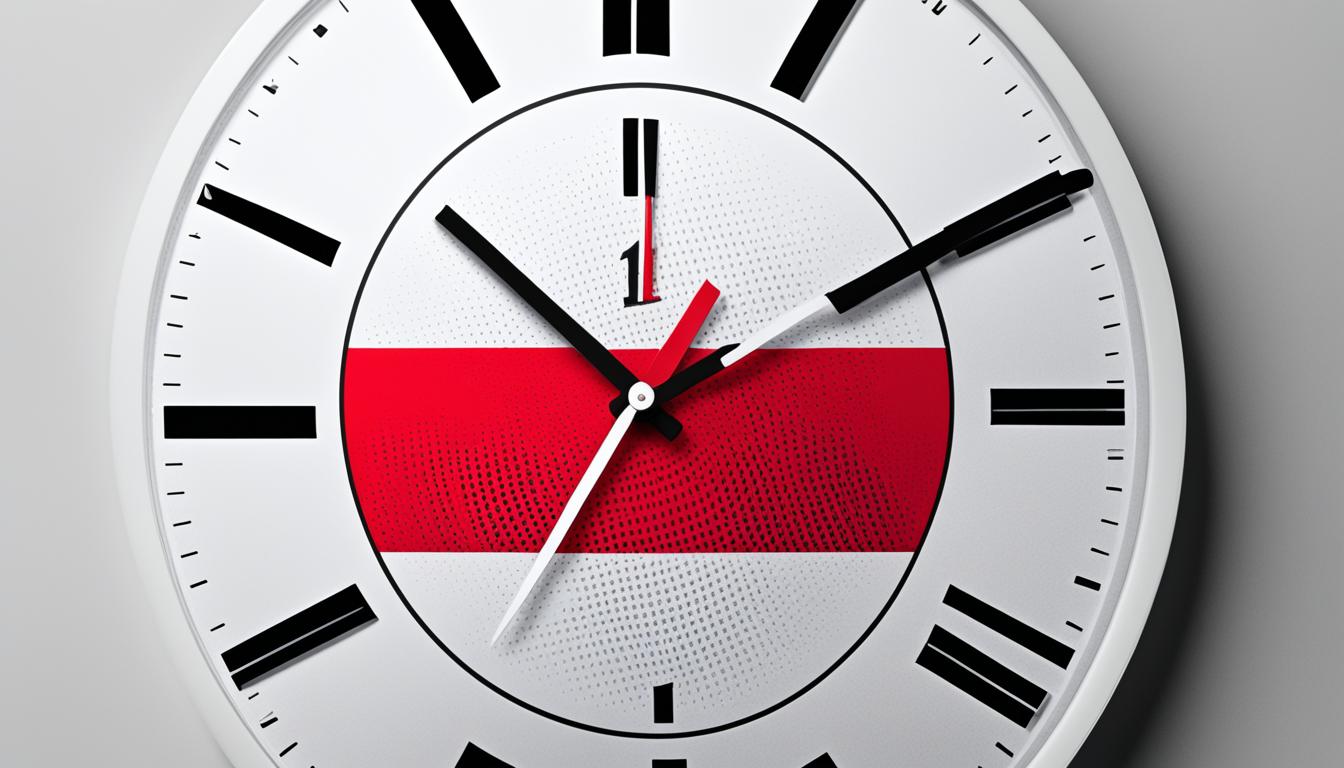Staying in sync with Poland’s current time is essential. It’s not just about checking the clock. It’s crucial for those engaged in global business, travel, and communication. An accurate Polish clock ensures harmony in both professional and personal connections.
For those inside and outside Poland, knowing the exact time is key. This knowledge helps manage international projects smoothly. It ensures all operations across various time zones work well together.
Poland stands at the crossroads of Eastern and Western Europe. In today’s globalised world, knowing the local time in Poland is vital. Accurate timekeeping supports progress and builds trust internationally. It shows the importance of being aware of Poland’s time in our connected world.
Key Takeaways
- Understanding Poland’s official time helps with worldwide teamwork and planning.
- Both business and pleasure depend on keeping accurate time in Poland.
- Technology makes it easy to find the current time in Poland for everyone.
- Dependable time services keep activities in line with Poland’s local time.
- Poland follows Central European Time, matching global time standards.
Understanding the Time Zone in Poland
Poland follows Central European Time (CET), one hour ahead of Coordinated Universal Time (UTC) during winter. The country aligns with CET because of its location. This helps Poland work smoothly with other European countries in business and travel.
However, Poland’s time isn’t just about its place on the map. The switch to Daylight Saving Time each year also plays a big role. This change affects society and the economy, especially when coordinating with other countries.
Geographical Influence on Poland’s Timekeeping
Poland’s proximity to the prime meridian affects its daylight hours. This impacts Polish daily life. Being in the CET zone means Poland’s daylight matches work hours well with similar countries.
Transition to Daylight Saving Time and Its Impact
The shift to Daylight Saving Time makes evenings longer in summer. It changes how people use energy and affects their mood and health. While it can confuse schedules, it also means more time for fun in the sun.
Coordinated Universal Time (UTC) and Central European Time (CET)
Knowing how Poland time compares to UTC is key for international relations. Poland is on CET, or UTC+1, in winter. But for Daylight Saving Time, it’s UTC+2. This keeps Poland in step with global time standards.
| Time Standard | Poland Time (Winter) | Poland Time (Summer) |
|---|---|---|
| Coordinated Universal Time (UTC) | UTC+1 | UTC+2 |
| Central European Time (CET) | CET (Standard Time) | CET (Daylight Saving Time) |
Time in Poland: Synchronisation with World Clocks
International time alignment is crucial for global interactions, with Poland playing a vital role. It’s essential for travel, ensuring flight schedules match worldwide. It’s also key for financial markets to function across time zones. Plus, online services need synced time to support live communication and data sharing.

The system for keeping global time in sync relies on complex tech. This ensures Poland’s time aligns with the world clock. As technology progresses, the importance of this system grows. Poland works with other countries to keep its clocks in sync with the world.
Poland’s role in time coordination benefits more than just big organisations. It matters for personal travel, international calls, and streaming services across borders. This shows how global time syncing impacts daily life.
Challenges in achieving unified world clock synchronization include technical and legal obstacles. However, the advantages of a reliable time system are huge. It boosts productivity, efficiency, and global connectivity. Poland’s part in this system helps the world keep time together.
Accessing Accurate Current Time in Poland Online
In our global village, keeping up with accurate time online is key. It helps with arranging worldwide webinars or checking time for important stock trades. Luckily, we now have the technology to do this with great accuracy. Let’s explore how certain platforms make this possible and the tech behind it.
Reliable Platforms for Time Checking
For reliable time checking websites, many use trusted sites like timeanddate.com and worldtimeserver.com. They give real-time updates on the official Poland time. These sites use internet time servers to get the exact time from reference clocks and share it.
How Technology Ensures Accurate Time Display
The core of these reliable platforms is advanced atomic clocks and network time protocols. Atomic clocks set the highest standard for accuracy, using atom vibrations. Network time protocols make sure the right time is shared everywhere.
Impact of Internet Time Servers on Precision
Internet time servers are crucial for keeping global time standards. They connect with precise atomic clocks, found in observatories or satellite systems. These servers are vital, making sure our gadgets show the right time, no matter where we are compared to Poland.
| Platform | Features | Technology Used |
|---|---|---|
| timeanddate.com | Time zone conversion, world clock, timers | Atomic clocks, GPS time feeds |
| worldtimeserver.com | Accurate local times, meeting planner, daylight saving updates | Network Time Protocol (NTP) |
Thanks to ongoing progress in technology and the strong setup of internet time servers, we’re always linked to precise time. For Poland, these technologies are crucial for planning and business, affecting our daily life and the world economy.
Conclusion
In this summary of time in Poland, we see the importance of knowing the local time clearly. This knowledge helps us do our daily tasks well and connect with people around the world. It’s not just about following Central European Time (CET) and changing the clock for Daylight Saving Time (DST). It’s also about matching time with other countries, which helps everyone work together smoothly.
Our final thoughts on Polish timekeeping highlight the role of reliable tools and advanced technology. Websites like timeanddate.com use atomic clocks and network time servers to keep time precise. This means people and businesses in Poland can always know the correct time. Being able to check the time online in Poland makes working with others, no matter where they are, easy.
This recap of Poland’s time synchronisation shows how vital accurate timekeeping is. It affects everything from business to planning our days. Poland, like other countries that value time precision, works hard to keep time accurately. This helps Poland play its part in making sure activities that depend on time go smoothly around the world.
FAQ
What is the current local time in Poland?
The current time in Poland follows Central European Time (CET). You can check it on websites that match the official Poland time standards.
How does Poland’s geographical location affect its timekeeping?
Poland is in Central Europe, affecting its sunlight and daily life. It uses Central European Time (CET) and shifts to Daylight Saving Time (DST) in summer. This means clocks go forward one hour to have more evening light.
When does Poland transition to Daylight Saving Time, and what is its impact?
Poland starts Daylight Saving Time (DST) at March end and stops at October end. This one-hour change affects businesses and international work.
What is the relationship between Coordinated Universal Time (UTC) and Poland’s time?
World time is set by Coordinated Universal Time (UTC). Poland’s time is UTC+1 hour usually and UTC+2 during Daylight Saving Time (DST).
How is time in Poland synchronised with world clocks?
Poland’s time matches global clocks through detailed time signals and protocols. This ensures accurate time across countries. It’s vital for travel, finance, and talking internationally.
Where can I find reliable platforms for checking the current time in Poland online?
To check Poland’s current time, use websites like timeanddate.com and worldtimeserver.com. They give exact time and sync with global standards and internet time servers.
What technology is used to ensure accurate time display online?
Accurate online time comes from atomic clocks and network time protocols. They help keep time exact on devices and systems.
How do internet time servers contribute to time precision?
Internet time servers are key for exact time, aligning with atomic clocks and global standards. This keeps devices and systems worldwide in sync.



